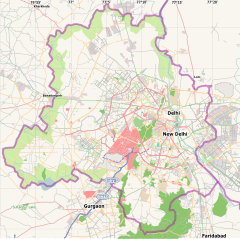Moti Masjid (Red Fort)
| Moti Masjid (Red Fort) | |
|---|---|
 Exterior view of the Pearl Mosque (Moti Masjid) of the Red Fort | |
| Religion | |
| Affiliation | Islam |
| District | Central Delhi |
| Ecclesiastical or organizational status | Mosque |
| Location | |
| Location | Delhi |
| Country | India |
| Territory | Delhi |
| Geographic coordinates | 28°39′25″N 77°14′35″E / 28.656815°N 77.243142°E |
| Architecture | |
| Type | Mosque |
| Style | Indo-Islamic |
The Moti Masjid (lit. 'Pearl mosque'[1]) is a white marble mosque inside the Red Fort complex in Delhi, India. Located to the west of the Hammam and close to the Diwan-i-Khas, it was built by the Mughal emperor Aurangzeb from 1659 to 1660.
History
The mosque was built by the Mughal emperor Aurangzeb at the Red Fort complex in Delhi, India, from 1659 to 1660 for his 2nd wife Nawab Bai. The mosque was also used by the ladies of the Zenana. The mosque was constructed at a cost of Rs. 160,000.[2]
The prayer hall has three arches, and it is divided into two aisles.[2] It is surmounted with three bulbous domes, which were originally covered in gilded copper.[3][4] The gilded copper was probably lost after the Indian rebellion of 1857.[dubious – discuss]
Architecture
The outer walls are oriented in symmetry with the outer walls of the fort, while the inner walls are at a slightly different orientation to align with the location of Mecca.[3] The eastern door is provided with copper-plated leaves.
The mosque is plastered in white on the outside. Inside is the white marble courtyard and a prayer hall, which stands on a higher level than the courtyard. The floor of the prayer-hall is inlaid with outlines of small carpets for prayers (musalla) in black marble. In the middle of the courtyard is a small, square ablution fountain. The courtyard measures 40 x 35 feet.[2]
Another small mosque by the same name was built for private prayer by Aurangzeb's son, the Mughal emperor Bahadur Shah I (r. 1707–1712), close to the Ajmere Gate of the Dargah of Sufi saint Qutbuddin Bakhtiar Kaki, which is located in Mehrauli at the Jahaz Mahal. It is an imitation of the one inside the Red Fort.
Gallery
-
Bronze main door with floral decoration
-
Interior view today
-
Samuel Bourne, "The Motee Musjid. Delhi. 1351," 1863–1869, photograph mounted on cardboard sheet, Department of Image Collections, National Gallery of Art Library, Washington, DC
References
- ^ "Moti Masjid of Red Fort - World Heritage Site - Archaeological Survey of India." Archaeological Survey of India (ASI). N.p., n.d. Web. 8 Feb. 2014.
- ^ a b c Murray, John (1911). A handbook for travelers in India, Burma and Ceylon (8th ed.). Calcutta: Thacker, Spink, & Co. p. 198. ISBN 978-1175486417. Retrieved 25 January 2014.
- ^ a b India. Lonely Planet. 2011. pp. 61, 63. ISBN 9781741797800.
- ^ "Moti Masjid of Red Fort". Archaeological Survey of India. Archived from the original on 10 February 2014. Retrieved 28 December 2013.
External links
![]() Media related to Moti Masjid (Red Fort) at Wikimedia Commons
Media related to Moti Masjid (Red Fort) at Wikimedia Commons





